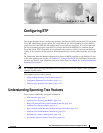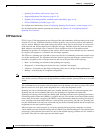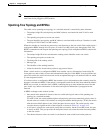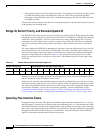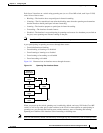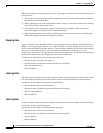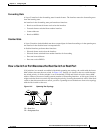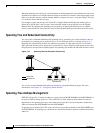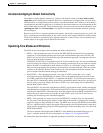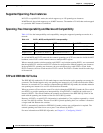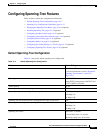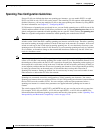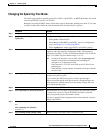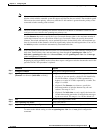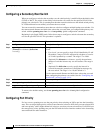
14-9
Cisco ME 3400 Ethernet Access Switch Software Configuration Guide
78-17058-01
Chapter 14 Configuring STP
Understanding Spanning-Tree Features
Accelerated Aging to Retain Connectivity
The default for aging dynamic addresses is 5 minutes, the default setting of the mac address-table
aging-time global configuration command. However, a spanning-tree reconfiguration can cause many
station locations to change. Because these stations could be unreachable for 5 minutes or more during a
reconfiguration, the address-aging time is accelerated so that station addresses can be dropped from the
address table and then relearned. The accelerated aging is the same as the forward-delay parameter value
(spanning-tree vlan vlan-id forward-time seconds global configuration command) when the spanning
tree reconfigures.
Because each VLAN is a separate spanning-tree instance, the switch accelerates aging on a per-VLAN
basis. A spanning-tree reconfiguration on one VLAN can cause the dynamic addresses learned on that
VLAN to be subject to accelerated aging. Dynamic addresses on other VLANs can be unaffected and
remain subject to the aging interval entered for the switch.
Spanning-Tree Modes and Protocols
The NNIs on the switch support these spanning-tree modes and protocols:
• PVST+—This spanning-tree mode is based on the IEEE 802.1D standard and Cisco proprietary
extensions. It is the default spanning-tree mode used on most Ethernet port-based VLANs. The
PVST+ runs on each VLAN on the switch up to the maximum supported, ensuring that each has a
loop-free path through the network.
The PVST+ provides Layer 2 load balancing for the VLAN on which it runs. You can create different
logical topologies by using the VLANs on your network to ensure that all of your links are used but
that no one link is oversubscribed. Each instance of PVST+ on a VLAN has a single root switch.
This root switch propagates the spanning-tree information associated with that VLAN to all other
switches in the network. Because each switch has the same information about the network, this
process ensures that the network topology is maintained.
• Rapid PVST+—This spanning-tree mode is the same as PVST+ except that is uses a rapid
convergence based on the IEEE 802.1w standard. This is the default spanning-tree mode for the
Cisco ME switch NNIs. Rapid PVST+ is compatible with PVST+. To provide rapid convergence,
the rapid PVST+ immediately deletes dynamically learned MAC address entries on a per-port basis
upon receiving a topology change. By contrast, PVST+ uses a short aging time for dynamically
learned MAC address entries.
The rapid PVST+ uses the same configuration as PVST+ (except where noted), and the switch needs
only minimal extra configuration. The benefit of rapid PVST+ is that you can migrate a large PVST+
install base to rapid PVST+ without having to learn the complexities of the MSTP configuration and
without having to reprovision your network. In rapid-PVST+ mode, each VLAN runs its own
spanning-tree instance up to the maximum supported.
• MSTP—This spanning-tree mode is based on the IEEE 802.1s standard. You can map multiple
VLANs to the same spanning-tree instance, which reduces the number of spanning-tree instances
required to support a large number of VLANs. The MSTP runs on top of the RSTP (based on IEEE
802.1w), which provides for rapid convergence of the spanning tree by eliminating the forward delay
and by quickly transitioning root ports and designated ports to the forwarding state. You cannot run
MSTP without RSTP.
The most common initial deployment of MSTP is in the backbone and distribution layers of a
Layer 2 switched network. For more information, see Chapter 15, “Configuring MSTP.”
For information about the number of supported spanning-tree instances, see the next section.



